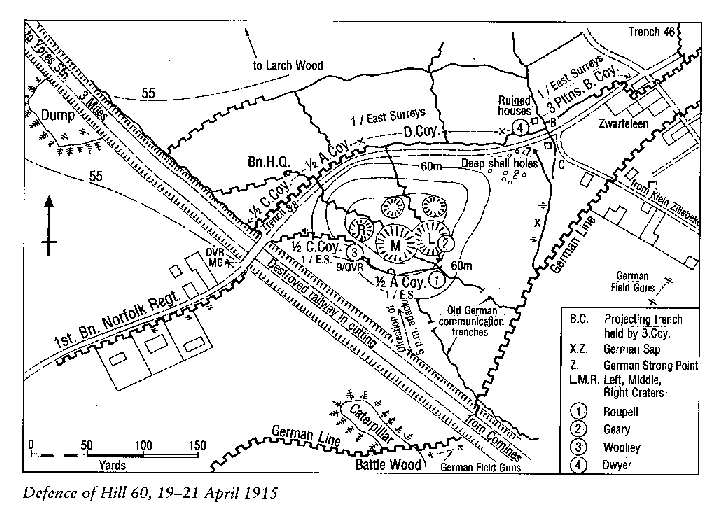
Hill 60 in 1914 was merely a low ridge some 150 feet high and 250 yard from end to end, formed artificially when the railway cutting was dug, receiving this name from our troops as signifying its height in metres on the contour map.
The hill itself has been preserved so the today's visitor can have access to one of the most infamous sites on the Salient.
The hill was captured on 10th December 1914 by the Germans. The British almost immediately that they arrived began digging tunnels under the hill and the German positions. This was was one of the first tasks of the newly created 171st Tunneling Company (under the command of Norton Griffiths - good book on the subject Barrie, A. [1961] War Underground. Ballantine Books. - a newer edition is now available). By Saturday 10thth April, digging at Hill 60 was about finished and six mines were ready for charging. M1 and M2 ran singly and roughly straight out under no-mans land for more than 100 yards. Then, just before reaching the German trench, each become two by forking right and left. The arms just a few yards long were enlarged to receive the gunpowder. The two other tunnels, M3 and M3A, which were had been in such peril from German countermining, were charged as were, no enlargement took place.. A charge of 2,700 pound was placed in each M1 chambers, M2 would receive two charges of 2000 pounds and M3 received only 500 pound each - because of the risk of German discovery.
Zero hour was set for 19:00 hour on the 17th April 1915. At 19:05, three officers of the 171st Tunneling Company hit the plunger, the resulting explosions ripped the heart out of the hill lasting over a period of 10 seconds. It flung debris nearly 300 feet in the air and scattered it for a further 300 yards in all directions. One British soldier who peered over the parapet was violently hit in the face by a piece of debris and killed him. As mud-lumps, sandbags, trench timbers and shattered German bodies were still spinning in the air, a huge Allied bombardment commenced saturating the German lines with fire and shrapnel. An attacking formation of Royal West Kent's, 2nd Kings Own Scottish Borders (with 2nd Duke of Wellingtons in support) and 1/9th (Queen Victoria Rifles) London's (with 2nd Kings Own Yorkshire Light Infantry in support) (their monument stands proudly on the summit of the hill to this day and the cafe / museum opposite also bears their name) with bayonets fixed scrambled up the hill. As the assaulting party closed on what was left of the German 172nd Regiment holding the hill, the dazed Germans screams could be heard over the battle dim, as the British bayonets sliced into them, about 150 died - only 20 were taken prisoner. Total British casualties were only seven.
A counter attack that night by the Germans inflicted heavy casualties on the defenders, forcing the British off the hill, though the next day., 18th April, the 2nd Duke of Wellingtons and 2nd Kings Own Yorkshire Light Infantry re-took the hill in new attack. These were relieved on the 19th April by men of the 1st Norfolk's, 1st Cheshire's, 1st Bedford's and 1st Dorset's with the 1/6th (Liverpool Rifles) King's in reserve. A further German attack was repelled with support from the 1st East Surreys. During which Lt George Roland Patrick Roupell won the VC on the 20th April (see VC page), the point at which he won his award is now the highest point on the hill.

Pictures from Hill 60
 Middle crater - looking North, not far from where
Roupell won his VC.
Middle crater - looking North, not far from where
Roupell won his VC.
 Small craters - looking North, towards British
front lines
Small craters - looking North, towards British
front lines
 Right crater - looking East, not far from where
Woolly won his VC.
Right crater - looking East, not far from where
Woolly won his VC.
 Queen Victoria Rifles Memorial.
Queen Victoria Rifles Memorial.
Words
to "The Old Barbed Wire
"
If you want to find the sergeant,
I know where he is, I know where he is.
If you want to find the sergeant,
I know where he is,
He's lying on the canteen floor,
I've seen him, I've seen him,
Lying on the canteen floor,
I've seen him,
Lying on the canteen floor.
If you want to find the quarter-bloke,
I know where he is, I know where he is.
If you want to find the quarter-bloke,
I know where he is,
He's miles and miles behind the line,
I've seen him, I've seen him,
Miles and miles behind the line,
I've seen him,
Miles and miles and miles behind the line.
If you want to find the sergeant-major
I know where he is, I know where he is.
If you want to find the sergeant-major
I know where he is,
He's boozing up the private's rum.
I've seen him, I've seen him,
Boozing up the private's rum.
I've seen him,
Boozing up the private's rum.
If you want to find the CO,
I know where he is, I know where he is.
If you want to find the CO,
I know where he is,
He's down in the deep dug-outs.
I've seen him, I've seen him,
Down in the deep dug-outs
I've seen him,
Down in the deep dug-outs.
If you want to find the old battalion,
I know where they are, I know where they are.
If you want to find the old battalion,
I know where they are,
They're hanging on the old barbed wire.
I've seen 'em, I've seen 'em,
Hanging on the old barbed wire,
I've seen 'em, I've seen 'em,
Hanging on the old barbed wire.